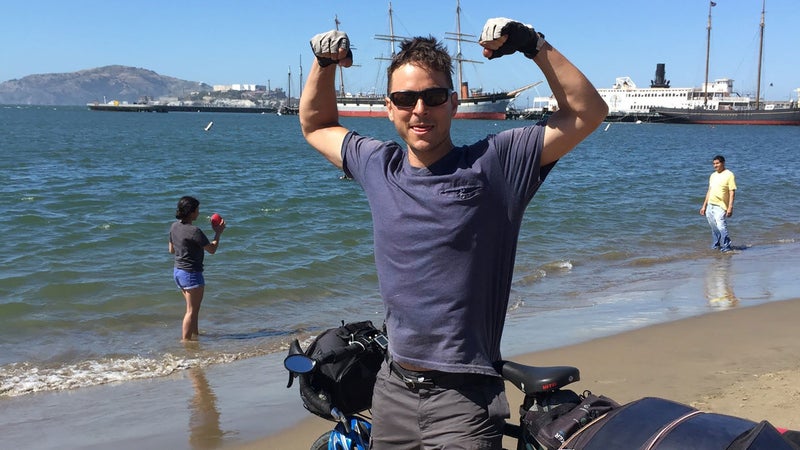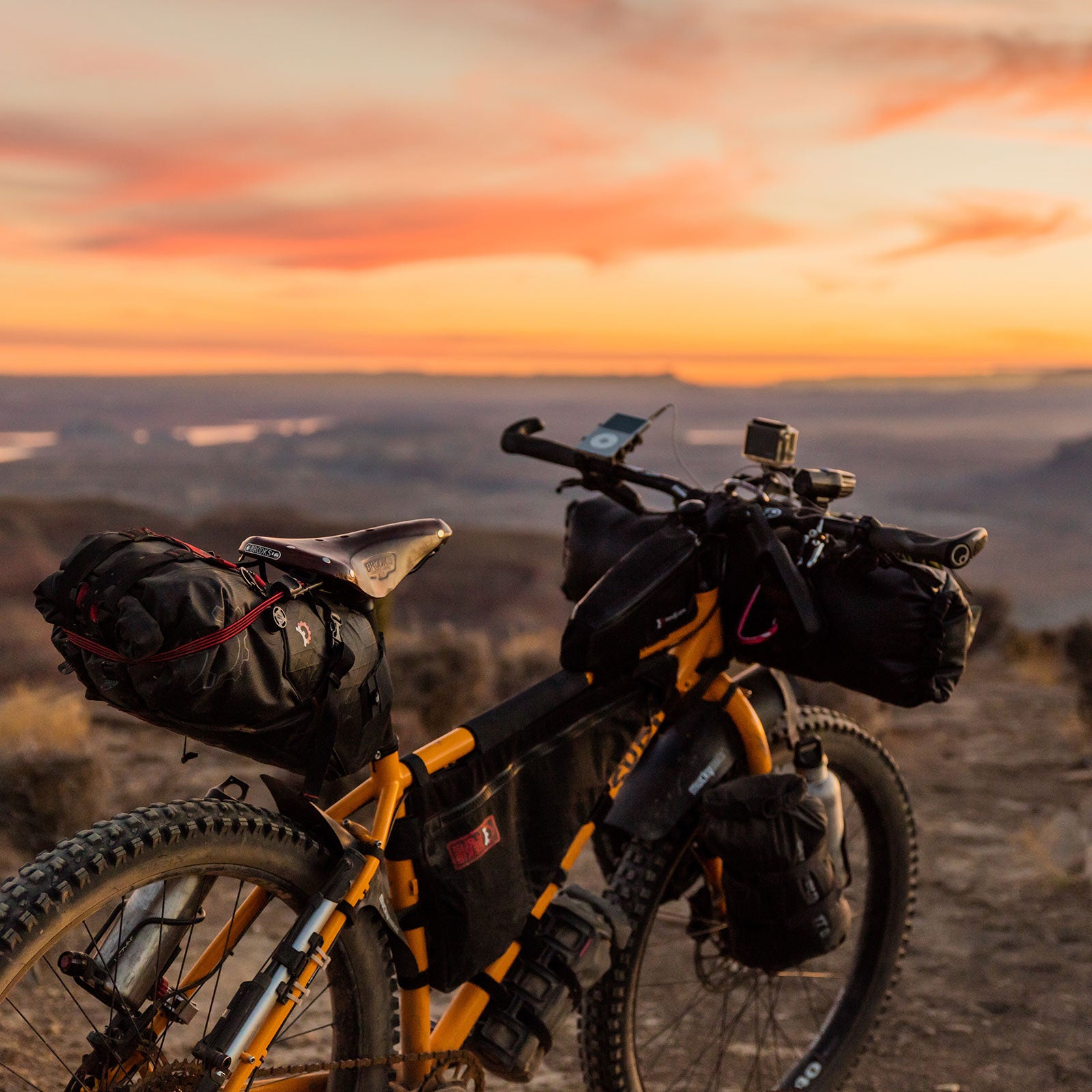For some of us, living a life of adventure feels like an impossible dream. That’s part of what makes Shane Dillon Gidcumb’s story so special. Shane, 38, a former winery executive and author of����book series, decided one day to radically change his life, leave his corporate office, and head out on an adventure: biking across the United States��and Europe. With a salary of $50,000 that he pieces together by��teaching and writing, Shane’s been able to experience the world and live out his dreams, one adventure at a time.
OUTSIDE: What made you decide to quit your job and ride across the United States��and Europe?
Shane Dillon Gidcumb: I worked for 11 years in the wine industry in Sonoma County, California. I started as an intern and left 11 years later as the vice president of the winery. Working in the wine industry was fun, but I felt like there was something missing in my life. By the end, I didn’t feel like I was learning anymore. It wasn’t that I was unhappy. I just felt like my days had turned into a monotonous routine with money being the only goal. One day��it occurred to me that I could go on doing this for the next 40 years. If I lived life this way, those 40 years could basically be condensed into a single week—repeated again and again. I knew I had to find a way to start learning and adventuring again.

How did you afford to do this, and what advice would you give to others who want to take that leap?
The theory of slow travel is that the slower you travel, the cheaper it becomes. Based on this idea, walking is the cheapest way to get around, and bicycling is a close second. Your biggest expense is food, which is essentially fuel. It’s amazing how your body becomes an efficient machine after a few weeks of bicycling eight hours a day.
During my bike��journeys on Disco��(yes, Disco is the name of my bike—you’d��be surprised by the things you think up while cycling eight hours a day for months),��I spent about $15 per day on food. In the beginning, I ate mainly at restaurants, and then I figured out it was cheaper and healthier to buy food from grocery stores to cook on my camp stove. For lodging, I tried to sleep in my tent as many nights as possible. I found most people would let me sleep in their backyards, and some even invited me into their homes for dinner and a shower. Other alternatives I used closer to cities were apps like����and . Sometimes, if I was desperate, I would just pitch my tent behind a church at sunset and make sure to be on the road by sunrise. There are a lot of free options to find a place to sleep at night.
The advice I would give to others is to just do it. I know it sounds crazy. In hindsight, I would make the same decision every time. Bicycle touring is a life-changing experience—essentially a crash course in minimalism.
What sort of gear do you have, and how much did you spend?
Before I left on my trip across the U.S., I had to buy all new gear. I made the mistake of buying cheap gear and having to upgrade later to a more durable setup. After cycling for a month, I was forced to replace my panniers, front handlebar bag, tent, and sleeping pad. These items are essential and can really improve the quality of life on the road. If at all possible, I recommend buying high-quality gear that will last. It will not only make your life easier, but it will also save you money in the long run.
Here’s my list of essential gear:
- Bike:
- Rear panniers:
- Front handlebar bag:
- Bivy��sack/tent:
- Sleeping bag:
- Sleeping pad:
- Socks:
- Chamois cream:
- Sunblock:
- Camera: An old Olympus digital camera converted to infrared
How do you make money now?
While cycling across the U.S., I started sending my résumé to teaching positions abroad. To my surprise, I landed a job in the south of Spain in a fishing village on the Mediterranean Sea. That was two years ago, and I have been living in Spain ever since. I work part-time at a grade school teaching English. The job provides a modest salary, a work visa, health insurance, and an abundance of free time. The money I make teaching is sufficient enough to get me through the school year. Then, in the summer, I dip into my investment account to fund my adventures. I am also a writer, and the money I make from my books definitely helps out.
What does your monthly budget look like?
Living in Spain, I am able to maximize the dollars I earned and saved in the U.S. My monthly budget is $1,200. Of that, I plan on spending half for fixed expenses, while the other $600 goes to my daily expenses. My daily budget is $20 per day, which is more than enough to live comfortably in Spain. On top of that, I set aside an additional $5,000 each year for travel. Currently, I live in Malaga, an ancient city on the Mediterranean.
Have you gleaned any money-saving tips over the years?
My creativity is a major form of my entertainment, and it actually pays for itself. One thing you learn about yourself while living on the road is how free time feeds your creativity. I’ve found that the more free time I have, the more productive I am from a creative standpoint. I don’t watch TV anymore, and my internet time is limited. Now all of my free time is devoted to my passions, which just so happen to be free. I am currently writing a personal finance book series for young adults��in addition to my photography. Physical fitness is important to me, and there are many low-cost options available, no matter where you live.
A few other tips? Each Sunday, I make two big pots of soup. I freeze individual servings and enjoy them throughout the week. A serving of soup costs less than $2. This is a great way to save money. When I go out for tapas with friends, I don’t feel bad about dining out.
I bike or walk everywhere I go in the city, which means I have nearly eliminated my transportation expenses. I was spending at least $400 a month on transportation in the states. Now I spend less than $10 a month. Essentially, I have eliminated one of my biggest expenses by living in Europe.
Finally, Google has an awesome cellphone plan called that works in more than 170 countries. This allows me to travel the world without worrying about expensive international rates. Monthly, I spend about $50 per month using this plan.
Where is your next adventure?
This summer, I’ve��decided to give Disco��some time off.��I’m��planning on doing two long hikes. First, I’m going to hike the Camino de Santiago in Spain. It’s about a 500-mile hike and will take about five weeks to complete. The second big hike I’m planning is a coast-to-coast trail across Ireland. It’s a little shorter and should take anywhere from three to four weeks to complete. One thing I have learned through my travels is that the journey inward is longer than journey outward. Last summer, I got in the habit of cycling during the day and working on my books at night. As there are more daylight hours than I can cycle or hike, I figured I would use my free time to write. During the day, I’m able to listen to podcasts to research for my book while pedaling. I plan on applying this same concept while hiking in Spain and Ireland.


